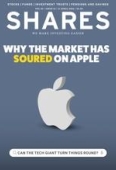Archived article
Please note that tax, investment, pension and ISA rules can change and the information and any views contained in this article may now be inaccurate.
Is the US in an ‘earnings bubble’ instead of a valuation bubble?

With the S&P 500 index having made more than 20 new highs this year, questions are being asked over the sustainability of the rally and the earnings growth which appears to be driving it.
Given the market gains have been led by technology – by way of which, Shares noticed the market cap of Microsoft (MSFT:NASDAQ) now eclipses that of the entire UK stock market – comparisons with the bubble of 2000 are inevitable.
Believers in tech will argue the bubble in 2000 was driven largely by unprofitable companies with poor business models, most of which went bust in the subsequent fall-out, whereas today’s rally is driven by highly profitable firms like Microsoft, Meta Platforms (META:NASDAQ) and especially Nvidia (NVDA:NASDAQ).
Therefore, runs the argument, the market can’t be in a bubble because it’s backed up by a mountain of earnings. Strategists at Goldman Sachs and JPMorgan argue the relative valuations of the ‘Magnificent Seven’ are actually lower today than they have been over the last five years.
Fair point, well made, you might say. Isn’t it possible though that rather than valuations being in a bubble, earnings themselves are in a bubble?
In the run-up to the great financial crisis, banks were clearly ‘over-earning’ relative to their natural growth rate thanks to clever financial engineering and a credit bubble caused by lending money to anyone with a pulse.
The same could be said of mining companies in the mid-2010s, when China was gobbling up commodities at an unprecedented rate and the price of everything from coal and copper to scrap steel went through the roof.
In both cases the supra-normal profits turned out to be short-lived and both sectors have since returned to their long-run ‘trend’ growth rates, which are pedestrian to put it mildly.
While the spectacular share price gains for stocks like Nvidia have so far been backed up by their earnings, is this really sustainable in the long run?
Ian Hartnett of Absolute Strategy Research suggests there is ‘a risk the market is engaging in its own Generative-AI ‘hallucination’ about how long these AI-related supra-normal sales and earnings can persist’.
Using S&P’s own data, full-year 2024 and 2025 earnings estimates for the S&P 500 are $218 and $250 respectively, with tech stocks expected to contribute roughly 24% of the total in both years against 20% last year and around 18% pre-pandemic.
In other words, there is an awful lot riding on the assumption earnings, which are already well above historic norms, will be able to stay there.
Important information:
These articles are provided by Shares magazine which is published by AJ Bell Media, a part of AJ Bell. Shares is not written by AJ Bell.
Shares is provided for your general information and use and is not a personal recommendation to invest. It is not intended to be relied upon by you in making or not making any investment decisions. The investments referred to in these articles will not be suitable for all investors. If in doubt please seek appropriate independent financial advice.
Investors acting on the information in these articles do so at their own risk and AJ Bell Media and its staff do not accept liability for losses suffered by investors as a result of their investment decisions.
Issue contents
Feature
Great Ideas
News
- Britvic shareholders left feeling flat as stock price decline continues
- Shareholders in Pinewood Technologies set for bumper special payout
- Can Dunelm demonstrate there’s no place like home?
- Can Johnson & Johnson beat first quarter expectations again?
- Strong labour market continues to undermine case for Fed rate cuts
- UK finance officers are bullish which is good news for the economy
- Could rising oil prices derail interest rate cuts?
- What is Microsoft-backed Rubrik, the latest firm to IPO in the US?
 magazine
magazine








